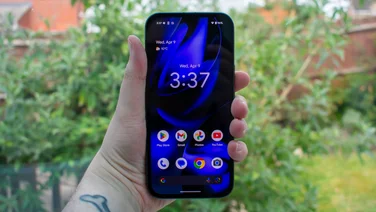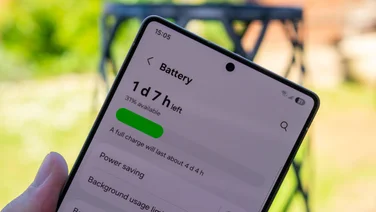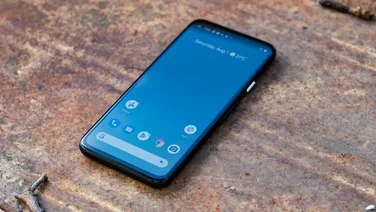To help us provide you with free impartial advice, we may earn a commission if you buy through links on our site. Learn more
- Apple iPhone 14 Plus review: What you need to know
- Apple iPhone 14 Plus review: Price and competition
- Apple iPhone 14 Plus review: Design and key features
- Apple iPhone 14 Plus review: Display
- Apple iPhone 14 Plus review: Cameras
- Apple iPhone 14 Plus review: Performance and battery life
- Apple iPhone 14 Plus review: Verdict











- Gorgeous 6.7in OLED display
- Decent battery life
- More easily repairable
- iPhone 14 Pro is better and not much more expensive
- Rear picks up fingerprints
- Same chipset as iPhone 13
The introduction of the iPhone 14 Plus this year was an indication of a significant subtext from Apple: that of price increases and not minor ones, either. However, instead of raising the prices of the iPhone 14 (£849), 14 Pro (£1,099) and 14 Pro Max (£1,199) by hundreds of pounds, Apple has introduced a model thats intended, eventually, to replace the cheapest model in the range.
The iPhone 14 Plus is that phone and the natural justification for it being more expensive than the regular iPhone 14 is the fact that its physically bigger, and that larger size naturally means a bigger screen and battery.
But does bigger really mean better? If you like phones with gigantic screens, then absolutely yes, but, as well see below, the iPhone 14 Plus offers little else over the regular iPhone 14 other than a much higher price, of course.
Apple iPhone 14 Plus review: What you need to know
The iPhone 14 Plus is a brand-new model from Apple, with the Plus denoting that it has a larger 6.7in OLED display than the iPhone 14 (6.1in). That display has a resolution of 2,778 x 1,284 for a sharpness of 458ppi, a 60Hz refresh rate and the same bathtub notch at the top as the regular iPhone 14 for housing the Face ID camera system. The Dynamic Island, which cleverly combines a smaller camera cutout with a notifications and alerts system, is only available on Apples Pro series of smartphones.
The larger size means the iPhone 14 Plus has a bigger battery inside 4,323mAh vs 3,279mAh but otherwise, the core specifications are identical to the smaller handset. Most significantly, that means the Plus remains stuck on last years Apple A15 Bionic chipset, where the iPhone Pro models have been moved up to the A16 Bionic. The A15 was used in last years iPhone 13/13 Pro models, so youre not getting any performance uplift for the increase in size or price.











There are, however, some upgrades worth noting. The main camera has been updated, and it now uses the same module as the iPhone 13 Pro did last year a 12MP unit with an f/1.5 aperture. This is accompanied by a 12MP ultrawide camera with an aperture of f/2.4 and a selfie camera that, at long last, has autofocus.
Additionally, the phone is more easily repaired (more on which below) and it can now detect if youve been in a severe car crash. The iPhone 14 Plus, rather unusually, can also send SOS messages via satellite, although this feature is only available initially to iPhone users in the US and Canada.
READ NEXT: Our full roundup of the best smartphones available
Apple iPhone 14 Plus review: Price and competition
Prices start at £949 for the iPhone 14 Plus, which gets you a phone with 128GB of storage, while upgrading to 256GB or 512GB bumps up the price to £1,059 or £1,279. Thats a LOT of money for a phone that remains stuck with a 60Hz display and last years chipset.
Its also £100 more expensive than the equivalent iPhone 14 (£849) and £150 cheaper than the lowest priced 14 Pro (£1,099). If youre spending this much on a smartphone, Id definitely recommend you go the extra mile and get a Pro instead.
Otherwise, its well worth checking out the Android competition. The Google Pixel 7 (£589) and 7 Pro (£849) are great examples that prove you dont have to spend nigh on a grand to get a very accomplished smartphone. The Pixel 7 Pro is £100 cheaper than the iPhone 14 Plus and has an extra 5x telephoto zoom camera plus a 120Hz display, while the Pixel 7 is £350 cheaper and, although smaller, even this comes with a screen that refreshes at 90Hz.
Also, check out the Samsung Galaxy S22 range. It might not be as new and shiny as the Pixel 7 but prices are very reasonable at the moment. The Samsung Galaxy S22 Plus, for instance, is of comparable size, costs £749 SIM-free and comes with an extra telephoto camera, just like the Pixel 7 Pro.
Apple iPhone 14 Plus review: Design and key features
If youve already read my iPhone 14 review or anyone elses, for that matter youll know what to expect of the iPhone 14 Plus. Its effectively an iPhone 14 but expanded to the size of an iPhone 14 Pro Max.
Its a fair bit clunker as a result, measuring 78 x 7.8 x 161mm (WDH) and weighing 203g. If youre used to a larger phone this probably wont bother you, but for those considering a move up from the smaller iPhone 13 or the 12 its a significantly larger handset. Its great for watching Netflix but not so good for slipping into your front jeans pocket.











Other than that, the phone looks and feels very much like its smaller sibling. Its slab-flat on the rear and front with a matte, coloured aluminium frame wrapping around the outside and a glossy finish (which picks up fingerprints rather too readily for my liking) on the rear.
The camera housing perches in the top-left corner on the rear with a pair of lenses peering out from a glass surround. The phone is available in the five colours: Midnight (a VERY dark blue), light purple, Starlight (white), light blue and Product Red.
The front glass uses Apples remarkably scratch-resistant Ceramic Shield technology and theres IP68 dust- and water-resistance, too, meaning the phone can be submerged in up to six metres of water for as long as 30 minutes. Its as robust a smartphone as you could possibly want, in other words.











Thats no different from last year but there are major aspects of the iPhone 14 Plus design that have been improved you just cant seen them with your eyes. Theres improved thermal performance, for example, so the phone doesnt overheat as readily but, more importantly, Apple has made the phone more easily repairable this time around.
Not only is the front glass easier to replace but the rear panel can now be swapped out too, without the need for a special machine. If you drop your phone on the floor and shatter the rear glass, this should mean that repairs dont run into the hundreds of pounds, as they have with previous models. Indeed, a quick hunt around on Apples website reveals that replacing the rear glass on the iPhone 14 Plus will cost you £199 instead of £369 on the iPhone 13 and £519 on the iPhone 14 Pro Max. Thats a major consideration for butter-fingered iPhone owners but youll still want a case.
Theres also the phones new ability to detect a car crash and make a phone call to emergency services for you, as well its satellite communications capability. The latter feature isnt available over here in the UK, or anywhere else apart front the US and Canada, so I havent been able to test it out, but when/if it does arrive it will allow you to send canned text messages to emergency services in the event you get into trouble in the great outdoors.
The crash detection is worth a little more of your time but hopefully its not a feature youre going to be using often unless youre a stock car driver or particularly careless behind the wheel but its nice to know that your phone has got your back if the worst does happen. Essentially, this feature is enabled by an upgraded accelerometer that can detect g-forces of up to 256 g, and this is used in combination with data from the barometer, microphones and GPS to do the detection. After the crash, the phone will call emergency services for you (and your emergency contacts) if you dont respond and tell it not to.
I dont have a spare car to test this feature out, unfortunately, but there are a few YouTube videos you can check out to see it in action. Its clear that it works in some cases but that the impact really does have to be quite severe for it to activate.
READ NEXT: Secure the best tablet available with our roundup
Apple iPhone 14 Plus review: Display
As with the rest of the range, the iPhone 14 Plus employs OLED technology for its 60Hz, 2,778 x 1,284 resolution display, and its a wonderful screen.











In testing, I measured gamut reproduction at 98.7% of P3, which is pretty much exactly what Apple claims for it. Maximum brightness reached 826cd/m² in everyday use, which is bright enough to remain readable in most situations, and that rose further to 1,203cd/m² in HDR playback.
With an effectively perfect contrast ratio and colour accuracy within sRGB an impressively low Delta E of 1.12, this is fantastic screen on which to consume any media, be that Andor on Disney Plus or your holiday snaps and home movies.
Apple iPhone 14 Plus review: Cameras
The cameras with which you capture those photographs and movie clips are pretty good, although only providing an ultrawide and a main rear camera in a phone costing near £1,000 is surprising.











Meanness aside, the main camera is a fairly solid upgrade on the iPhone 13. As mentioned above, it inherits the camera module from the iPhone 13 Pro, which comes with a brighter f/1.5 aperture and sensor-shift stabilisation, as well as Apples new Photonic Engine image processing, which improves image quality across all three cameras.
Other improvements include a smoother video mode called Action Mode, which sacrifices some resolution to deliver action-camera style footage. And Cinematic Mode, which adds fake background blur to video, can now be captured in 4K it was restricted to 1080p in the iPhone 13 and iPhone 13 Pro.
It cant quite match the excellent 48MP camera on the iPhone 14 Pro, which is genuinely brilliant, but it captures superb shots in good and low light. Video capture at up to 4K in Dolby Vision is sumptuously good, although you need to be careful to avoid bright light sources moving car headlights, for instance in dim scenes as these can create distracting reflections off the inside of the protective glass over the iPhones lenses.
If you want to see comparison shots between the iPhone 14 and the iPhone 13 Pro, you should read my iPhone 14 review and scroll down to the camera section. Suffice to say, there isnt a huge difference in quality, despite the fact that the iPhone 14 has Apples Photonic Engine processing and the iPhone 13 Pro doesnt.


Here, Im going to compare the quality of the cameras in the iPhone 14 Plus to those in the iPhone 14 Pro, just to show you what youll be missing out on if you plump for the cheaper phone. In good light, as with most decent smartphones these days, the differences are marginal. In fact, colours are strong, images and videos are packed with details and theres nothing really to complain about.However, even though low-light performance is a little better than the iPhone 13 and the iPhone 13 Pro, its nothing compared with the performance of the iPhone 14 Pros main camera. Have a look at the comparison shot below and youll instantly see the difference: theres better detail, and far superior colour reproduction in the iPhone 14 Pros image.I could post more examples here but you get the gist. The iPhone 14 Pro, at only £150 more, delivers significantly better camera performance. Thats a premium I think that you should seriously consider paying.
READ NEXT: Get the right Apple Watch for you with our handy guide
Apple iPhone 14 Plus review: Performance and battery life
Apples decision to put the same chipset in the iPhone 14 as last years iPhone 13 has been widely criticised, and rightly so. It gives users one fewer reason to upgrade and it makes those buying the non-Pro handsets feel like theyre missing out.



What this doesnt mean, however, is that the iPhone 14 Plus is a slow phone. In actual fact, if you look at the benchmarks, youll see that, although it lags behind the A16 Bionic-equipped iPhone 14 Pro, its still significantly faster than the Samsung Galaxy S22 Plus and the otherwise excellent Google Pixel 7 Pro.And battery life is terrific, too. In fact, this is the longest lasting non-Pro iPhone weve ever tested with a result of 23hrs 18mins in our battery-rundown test, and it also beats both the Samsung Galaxy S22 Plus and Google Pixel 7 Pro.
Apple iPhone 14 Plus review: Verdict
All of which makes the iPhone 14 Plus rather difficult to rate. In isolation, its a fine smartphone with a competent camera, a big, gorgeous display and impressive battery life.
On the other hand, you can get the iPhone 14 Pro (£1,099) for only £150 less or an iPhone 14 (£849) for £100 less than that, which apart from the smaller display and slightly poorer battery, is just as good in most other respects. Alternatively, you can grab an iPhone 13 (£749) for £200 less and the differential, again, isnt all that huge.
Ultimately, though, the biggest problem the iPhone 14 Plus faces is that the gap it slots into is pretty small and, critically, the sunlit uplands of the iPhone 14 Pro range are only a small investment away. If you can justify spending this much on a smartphone, do yourself a favour and save a little more and grab an iPhone 14 Pro instead. Youll be much happier with it in the long run.





